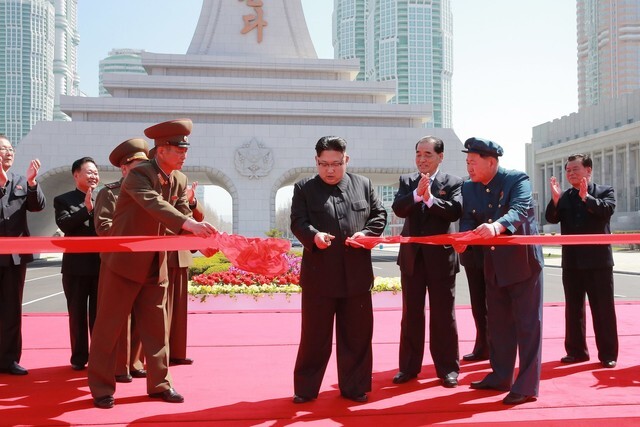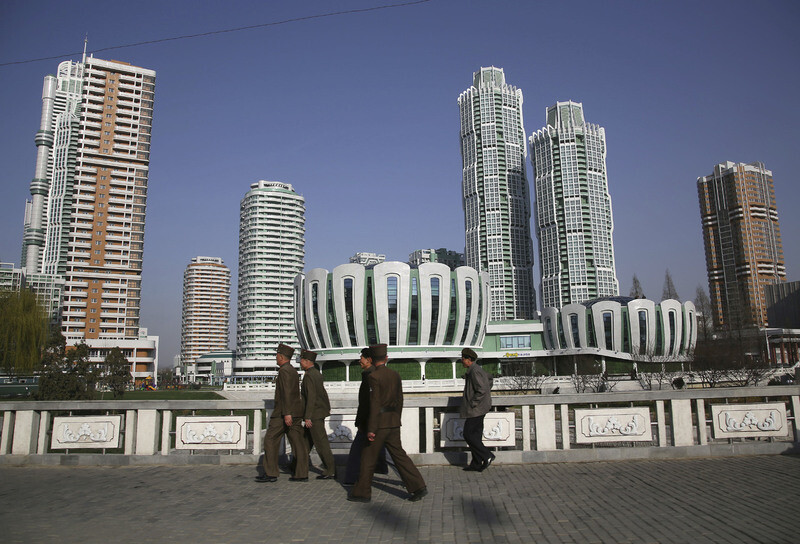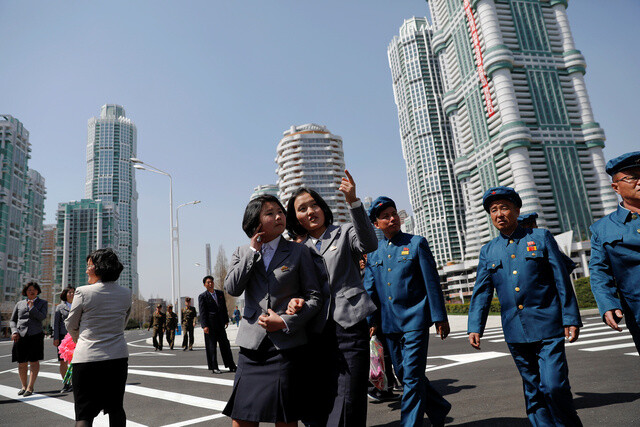hankyoreh
Links to other country sites 다른 나라 사이트 링크
[News analysis] The “masters of money” behind North Korea’s development projects

The completion ceremony for the Ryomyong Street development project in Pyongyang, North Korea, was held on Apr. 13, 2017. Videos and photographs that showed North Korean leader Kim Jong-un cutting the ribbon were broadcast around the world.
Ryomyong Street is an eight-lane street that runs for 3km from the Kumsusan Palace of the Sun to the Tower of Immortality in Pyongyang’s Taesong District. The development of the area involved the construction of 60 public buildings and 40 high-rise apartment towers (soaring up to 45, 50, 55, 70 and even 82 stories). The 82-story apartment towers, which are 270m high, are the tallest buildings in North Korea, with the exception of the Ryugyong Hotel. Five of North Korea’s 10 tallest buildings are apartments on Ryomyong Street.
When Kim Jin-song, a construction manager on the Ryomyong Street project, confessed in the July 2016 issue of North Korean magazine Kumsugangsan that “I had no experience building a 70-story apartment before,” it wasn’t an act of false modesty. The development has been called “an ideal street in socialist civilization” (Pak Pong-ju, premier of North Korea) and “a fairyland in the age of the Workers’ Party of Korea” (the Rodong Sinmun, the party’s organ).
Construction on this development began on the orders of Kim Jong-un on Mar. 18, 2016, and was wrapped up on Apr. 13, 2017, a little over a year later. That’s a pace that would be impossible for South Korea’s top construction firms, typically the global leaders in getting things done in a hurry. And that happened while the UN and the US were tightening the screws of sanctions and storm clouds were gathering over the Korean Peninsula because of North Korea’s repeated nuclear weapon tests and missile launches.

Ryomyong Street is just one of a string of similar developments that have been completed in Pyongyang since Kim Jong-un came to power, including Changjon Street (2012), Unha (Galaxy) Scientists Street (2013), Wisong (Satellite) Scientists Residential Street (2014) and Mirae (Future) Scientists Street (2015). A total of 14 street development projects have been carried out by the party since Pyongyang was rebuilt as a planned city after the Korean War, and five of those have taken place since Kim Jong-un has taken power.
Where did North Korea get the energy to complete this development project at such a whirlwind speed, despite the shortage of materials and experience resulting from the tightened sanctions on the country? Was this one of the Kim Jong-il-inspired “speed battles” that are thought to have crippled the North Korean economy since the 1970s? The key to solving this riddle lies with North Korea’s emergent entrepreneurial class, the donju, literally meaning “masters of money.”
“The reality in North Korea is that completing a state construction project would be inconceivable if not for the donju,” said Yang Mun-su, a professor at the University of North Korean Studies.
The donju are responsible for sourcing construction materials that are either in short supply or impossible to come by in North Korea. Experts believe it would be impossible to speed up construction projects without the donju’s capital and their ability to quickly bring in materials from China.
The process works as follows. State construction projects are assigned to the party, cabinet and army. Officials at each of these organizations line up donju to take charge of the construction in exchange for concessions. The donju make “contracts” that guarantee them the usage rights of some buildings in the project, which will earn them a return that’s greater than their investment.

In reality, the state construction projects under Kim Jong-un represent a combination of private-sector funding and public-private joint ventures. But since, legally speaking, private-sector construction firms aren’t allowed to exist, the donju’s role is outside the law. Their contracts have no legal force. Putting idle funds in the private sector to use is encouraged, but giving donju “usage rights” (in effect, ownership) is not recognized.
That said, the donju aren’t robbed of their investments or sent to prison for collusion, either. Instead, donju that make big investments and that are cozy with powerful figures are recognized as “heroes of labor” or given the “Kim Jong-un Merit.” This symbiosis exists in a gray area between what’s legal and what’s illegal.
Under Kim Jong-un, that gray area has been rapidly expanding. The symbiosis between state-run enterprises and donju is spreading into a wide range of areas.
By way of illustration, suppose that a Chinese trading company asks a North Korean trading company to supply it with 10,000 wigs within a month. The trading company produces 1,000 of the wigs at a factory under its control and farms out the other 9,000 to a donju-controlled network of producers. The donju pay state-run enterprises they’ve done business with before to produce the wigs. In effect, the state-run enterprises are acting as toll processing firms completing orders for the donju.
Donju also act as manufacturers, by either borrowing the name of state-run enterprises or acquiring usage rights for their own factories and machinery. The North Korean law doesn’t allow the private ownership of the means of production, but the reality is a different matter.
In 2015, Yang Mun-su and other researchers asked North Korean defectors about the percentage of state-run enterprises that are invested in or directly operated by individuals (that is, by donju). The results of this survey were as follows: 64.1% of restaurants, 56.2% of stores, 26.2% of manufacturing facilities on the periphery and 21.7% of manufacturing facilities in the core. That suggests how many individual businesspeople are now profiting from other people’s labor through what amounts to corporate privatization.
The spread of state enterprises that are public in name only is a change resulting from a “chemical reaction” between ongoing marketization and the policy of increasing corporate autonomy, which are themselves the product of Kim Jong-un’s “North Korean-style economic management methods” and the system of management accountability at socialist corporations. Just as in a capitalist economy, competition has intensified, producing inequality.
For example, the manager of the Hwanggumbol Store (which opened in Dec. 2014) openly emphasizes how his store stands out from the competition: “We’ve extended our hours of operation from 6 am to 12 pm, which is more than other stores. We set reasonable prices and oversee product quality.” The nominal operator of this store is Hwanggumbol Trading Corporation, a state-run enterprise.
The Hwanggumbol Store chain relies on a strategy of high volume, low margin sales, rather like South Korea’s hypermarkets. This is North Korea’s first chain of supermarkets: it simultaneously opened branches in Pyongyang’s Potanggang and Chung districts and has been gradually expanding its network of operations since then. Trying to figure out customer preferences is now an essential part of running a business in North Korea, too.
Yang describes the donju and the state-run enterprises that are rapidly changing through their partnerships with the donju as “companies wearing red hats,” red being a reference to socialism. This is reminiscent of the “township and village enterprises,” or TVEs, that were an early growth dynamo during China’s period of reform and opening. Established in rural areas and owned either collectively or individually, the TVEs operated in non-farming sectors (such as manufacturing, transportation and services) and were not controlled by the state.
By Lee Je-hun, senior staff writer
Please direct comments or questions to [english@hani.co.kr]

Editorial・opinion
![[Column] Life on our Trisolaris [Column] Life on our Trisolaris](https://flexible.img.hani.co.kr/flexible/normal/500/300/imgdb/original/2024/0505/4817148682278544.jpg) [Column] Life on our Trisolaris
[Column] Life on our Trisolaris![[Editorial] Penalties for airing allegations against Korea’s first lady endanger free press [Editorial] Penalties for airing allegations against Korea’s first lady endanger free press](https://flexible.img.hani.co.kr/flexible/normal/500/300/imgdb/original/2024/0502/1817146398095106.jpg) [Editorial] Penalties for airing allegations against Korea’s first lady endanger free press
[Editorial] Penalties for airing allegations against Korea’s first lady endanger free press- [Editorial] Yoon must halt procurement of SM-3 interceptor missiles
- [Guest essay] Maybe Korea’s rapid population decline is an opportunity, not a crisis
- [Column] Can Yoon steer diplomacy with Russia, China back on track?
- [Column] Season 2 of special prosecutor probe may be coming to Korea soon
- [Column] Park Geun-hye déjà vu in Yoon Suk-yeol
- [Editorial] New weight of N. Korea’s nuclear threats makes dialogue all the more urgent
- [Guest essay] The real reason Korea’s new right wants to dub Rhee a founding father
- [Column] ‘Choson’: Is it time we start referring to N. Korea in its own terms?
Most viewed articles
- 1New sex-ed guidelines forbid teaching about homosexuality
- 260% of young Koreans see no need to have kids after marriage
- 3[Column] Life on our Trisolaris
- 4OECD upgrades Korea’s growth forecast from 2.2% to 2.6%
- 5Presidential office warns of veto in response to opposition passing special counsel probe act
- 6Months and months of overdue wages are pushing migrant workers in Korea into debt
- 7[Guest essay] Maybe Korea’s rapid population decline is an opportunity, not a crisis
- 8[Editorial] Penalties for airing allegations against Korea’s first lady endanger free press
- 9[Reportage] On US campuses, student risk arrest as they call for divestment from Israel
- 10Korea sees more deaths than births for 52nd consecutive month in February